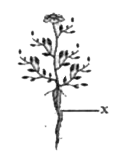Chloroplasts are green-coloured plastids found in the leaves of plants. They perform the function of
controlling the activities of the cell
carrying out photosynthesis
storing cellular waste
protecting the cell
Step-by-Step Solution:
1. Identify the Structure of Chloroplasts:
- Chloroplasts are green-colored plastids found in the leaves of plants. They are double membrane-bound organelles, consisting of an outer membrane and an inner membrane.
2. Understand the Role of Chlorophyll:
- Inside the chloroplasts, there is a pigment called chlorophyll. This pigment is crucial because it traps light energy from the sun, which is essential for the process of photosynthesis.
3. Define Photosynthesis:
- Photosynthesis is the process by which plants convert light energy into chemical energy, specifically in the form of glucose (food). This process occurs primarily in the chloroplasts.
4. Explain the Function of Chloroplasts:
- The main function of chloroplasts is to carry out photosynthesis. They are often referred to as the "kitchen of the cell" because they produce food for the plant.
5. Describe the Internal Structure:
- Within chloroplasts, there is a fluid-filled space called stroma, where various reactions of photosynthesis occur. Additionally, there are structures called thylakoids, which are arranged in stacks known as granum. These thylakoids contain chlorophyll and are where the light-dependent reactions of photosynthesis take place.
6. Summarize the Functions:
- In summary, chloroplasts are responsible for:
- Carrying out photosynthesis to produce food.
- Trapping light energy through chlorophyll.
- Storing energy in the form of glucose.
- Chloroplasts are green-colored plastids found in the leaves of plants. They are double membrane-bound organelles, consisting of an outer membrane and an inner membrane.
- Inside the chloroplasts, there is a pigment called chlorophyll. This pigment is crucial because it traps light energy from the sun, which is essential for the process of photosynthesis.
- Photosynthesis is the process by which plants convert light energy into chemical energy, specifically in the form of glucose (food). This process occurs primarily in the chloroplasts.
- The main function of chloroplasts is to carry out photosynthesis. They are often referred to as the "kitchen of the cell" because they produce food for the plant.
- Within chloroplasts, there is a fluid-filled space called stroma, where various reactions of photosynthesis occur. Additionally, there are structures called thylakoids, which are arranged in stacks known as granum. These thylakoids contain chlorophyll and are where the light-dependent reactions of photosynthesis take place.
- In summary, chloroplasts are responsible for:
- Carrying out photosynthesis to produce food.
- Trapping light energy through chlorophyll.
- Storing energy in the form of glucose.
Topper's Solved these Questions
- BASIC BIOLOGYBOOK - BETOPPERSCHAPTER - BASIC BIOLOGYEXERCISE - Conceptive Worksheet
32 Videos
- BASIC BIOLOGYBOOK - BETOPPERSCHAPTER - BASIC BIOLOGYEXERCISE - Summative Worksheet (Multiple Choice Questions-Tick mark the correct choice)
18 Videos
- DIGESTIONBOOK - BETOPPERSCHAPTER - DIGESTIONEXERCISE - SUMMATIVE WORKSHEET
3 Videos
Similar Questions
Knowledge Check
Chloroplasts perform the function of
AosmosisBrespirationCtranspirationDphotosynthesisPhloem in the plants perform the function of
Aconduction of foodBconduction of waterCproviding supportDphotosynthesisPhloem in the plants perform the function of:
Aconduction of foodBconduction of waterCproviding supportDphotosynthesis

